Table of contents
Eggplant ( Solanum melongena) refers to the fruit of the nightshade plant of the same name. Raw eggplants are often available in organic quality and can be used in many different ways in the kitchen, but should not be eaten raw.
Use in the kitchen
The fruits of the most common variety of eggplant in Europe reach a size of up to 20 cm. They have a dark purple to black skin and an elongated, club-like shape. The base of the stalk can often have sharp spines.
Can you eat an eggplant raw? It is assumed that modern varieties have a relatively low content of glycoalkaloids. 21,22 Nevertheless, it is better not to eat eggplant raw. Eggplants can be cooked, steamed or baked, including the skin and seeds, and can be used in both cold and warm dishes.
The taste of the eggplant fruit is rather mild, so it is a good carrier for various types of spices, such as ground cumin or garam masala.
There are recommendations to salt eggplant slices before cooking, which draws out the liquid from the fruit. This is supposed to remove bitter substances and prevent the absorption of fat when frying. However, we cannot confirm this. The fat can easily penetrate the cell walls anyway - and the suction effect may even be increased by the lack of liquid. Salting softens the skin, which shortens the cooking time later, and it intensifies the flavor, which is better achieved with spices. After letting it soak for around 10 minutes, you should carefully dab off the liquid and the salt with a kitchen towel. To prevent the sliced eggplant slices from turning brown, you can sprinkle them with lemon juice (before salting).
The eggplant is particularly popular in Mediterranean and oriental cuisine. The flesh, which is easy to remove after roasting, can be made into a paste (Baba Ganoush) with tahini. This makes a tasty vegan dip for fresh vegetables such as carrots or cucumbers.
In Italy, eggplant is a component of numerous dishes, e.g. caponata or eggplant casserole (melanzane alla parmigiana). The correct Italian name 'melanzana' (plural: melanzane) is echoed in the Austrian name 'die Melanzani'. This fruit is also an important ingredient in the moussaka known from Greece or Turkey. The hearty dish can also be prepared using purely plant-based ingredients, for example using tofu or bulgur as a meat substitute.
Overall, the eggplant can be used in many different ways, including as a vegetable addition to tomato sauce or as an ingredient in vegan curries or soups. Steamed, it also makes a great filling for wraps or in salads. Gently baked or fried, it tastes great as a starter or side dish to oriental dishes. Due to its shape, the eggplant is also ideal for filling with rice, millet or quinoa.
Vegan recipe for caponata with eggplant
Ingredients (for 2 people): 1 red onion, 3 cloves of garlic, 2 stalks of celery, 3 tomatoes, 1 eggplant (organic), 1 tbsp capers, 6 black olives (pitted), 2 tbsp red wine vinegar, fresh parsley, salt & pepper.
Preparation: Peel the onion and cut into fine cubes, peel the garlic cloves and chop finely. Peel the celery sticks and cut into thin slices, cut the washed tomatoes and the raw eggplant into cubes. Sauté the onion pieces with the celery in a deep pan with a little water, add the eggplant and garlic after 5 minutes and simmer for another 10 minutes. Then add the tomatoes and vinegar and simmer for 10 minutes at a low heat. Finally, mix in fresh, chopped parsley, capers and olives, ideally let it infuse a little and season with salt and pepper. Serve the vegan dish lukewarm.
Vegan recipes with eggplant can be found under the note: " Recipes that have the most of this ingredient ".
| Not only vegans or vegetarians should read this: Vegans often eat unhealthily. Avoidable nutritional errors. |
Purchasing - Storage
Aubergines are in their main season in the summer months, 2 but you can usually buy them all year round in supermarkets such as Coop, Migros, Denner, Volg, Spar, Aldi, Lidl, Rewe, Edeka, Hofer, Billa. Some of them are organic, otherwise you can buy them at Denn's Biomarkt or Alnatura which often offer regionally grown produce. You should buy eggplants while they are still firm - this way you avoid specimens that have been stored for too long. The browner the seeds are (often referred to as black spots), the riper the fruit. If the fruit is overripe, there is a risk of fungal infection; in addition, the European Food Safety Authority ( EFSA) was able to detect a significantly higher content of glycoalkaloids in overripe eggplants. 8
The availability of ripe eggplants varies depending on the size of the store, catchment area, etc. Our recorded food prices for the DA-CH countries can be found above under the ingredient image - and by clicking on them you can see their development at different suppliers.
Storage tips
Fresh organic eggplants are stored in the vegetable compartment of the refrigerator. They will keep for several days there. The best way to test whether the eggplant is overripe is to press on the fruit, which ideally should not give way. As it ripens, the eggplant loses its shine and develops brown spots. Even if overripe eggplants are still edible, they should be prepared quickly.
Ingredients - Nutritional values - Calories
A raw eggplant consists of up to 92% water and is rather low in energy with 25 kcal/100g. The protein (0.98 g/100g) and fat content (0.18 g/100g) are also very low. 5
With a content of 229 mg/100g, eggplants are a good source of potassium. Tomatoes (237 mg/100g) and butternut squash (222 mg/100g) have similar values. Foods with a much higher potassium content are dried tomatoes (3427 mg/100g) and soybeans (1797 mg/100g).
The vitamin content in eggplants is rather low: we are talking about 0.08 mg of vitamin B6 per 100 g and a vitamin C content of 2.2 mg/100g. In this case, it is better to use pistachios, which have a vitamin B6 content of 1.7 mg/100g, or yellow bell peppers with a vitamin C content of 184 mg/100g.
Despite their low energy and vitamin content, eggplants contain important fiber, which is beneficial for digestion. 6 Eggplants also contain important minerals, particularly sodium, manganese and calcium. 7
The total ingredients of eggplant (raw), the coverage of the daily requirement and comparison values with other ingredients can be found in our nutrient tables. In the article Nutrients explained you will get a detailed insight into the topic.
Health effects
The health effects of eggplants are due to the secondary plant substances they contain.
Secondary plant substances
Our article on secondary plant substances provides an overview of the classification of substance groups, their occurrence in foods and possible effects on humans. Eggplant contains the following secondary plant substances:
- Isoprenoids: Steroids (Gramisterol, Lanosterol), carotenoids 6.19
- Alkaloids: Steroid alkaloids (alpha-solarmargin, beta-solasonine, solasodine), tropane 6, 8
- Polyphenols: phenolic acids (chlorogenic acid, caffeic acid, p-coumaric acid), flavonoids: flavones (apigenin), flavonols (isorhamnetin, kaempferol, quercetin), anthocyanins (nasunin, delphinidin, delphinidin glucoside, delphinidin 3-O-rutinoside, cyanidin 3-O-rutinoside, petunidin 3-O-rutinoside) 7,11,19,23
- Other organic compounds: Oxalic acid 6
However, it should be noted that the composition of secondary plant substances in raw eggplants can vary depending on the variety, time of harvest and growing conditions. Therefore, quantities are only of limited use and should only be understood roughly.
Is eggplant healthy? The strong coloring of eggplants is caused by the anthocyanins they contain, which protect the plants from UV radiation and drought stress. 12 Purple eggplants in particular contain a lot of nasunin. It can reduce lipid oxidation and the accumulation of reactive oxygen species (ROS) and prevent chronic diseases such as cancer or diabetes. 7,11
The antioxidant effect of carotenoids and flavonoids in eggplant can reduce the risk of cancer, but also of cardiovascular diseases. The fiber in eggplant helps the body to eliminate toxins and harmful substances in the digestive tract and can therefore reduce the risk of stomach or colon cancer. 6
Due to the variety of bioactive compounds found in eggplant, it also has antibacterial, anti-inflammatory, antiallergic, hepatoprotective, antithrombotic, antiviral, anticarcinogenic and vasodilatory properties. 19
When eating eggplants, it is important to remember that the stability of anthocyanins decreases with increasing temperature, and they turn into colorless or insoluble brown pigments. Heat treatment in the food industry for food preservation also leads to a significant decrease in phenolic compounds. According to a study, the smallest loss of anthocyanins and antioxidant capacity occurs at a temperature of 80 °C. The total anthocyanin content decreased by 20% after 30 minutes and by 59% at 130 °C. The antioxidant capacity was less sensitive to the heat. At 80 °C it decreased by 2.8% and at 130 °C by 12%. 11
Dangers - Intolerances - Side effects
As mentioned above, the fruits of the eggplant plant should not be eaten raw to be on the safe side. Eggplant flowers and leaves are also not suitable for consumption due to their content of glycoalkaloids 8.
Like other glycoalkaloids, solanine is a natural protective mechanism of plants against predators. In everyday language, the term solanine is often used as a collective term for many different glycoalkaloids in nightshade plants. 21 However, solanine is only really relevant for food safety in the context of the potato plant, which contains solanine and other Solanum alkaloids in higher concentrations than eggplant or tomatoes. 8,22 Consumption of solanine can lead to poisonous conditions. These include diarrhea, nausea, dizziness or headaches. In more serious cases, hallucinations and fever can also occur. 21
Individual studies have shown small amounts of nicotine in eggplants. 9 Other nightshade plants such as tomatoes and potatoes also show this phenomenon. However, the amounts are so small that they are sometimes difficult to measure. 10 Accordingly, there are also studies that show no measurable nicotine content. 9
Ecological footprint - animal welfare
The ecological footprint of eggplants depends on the season, the country of origin and the means of transport. If the climatic conditions in a country do not allow eggplants to be grown outdoors, the plants are grown in greenhouses, which sometimes requires additional heating. Depending on the calculation method, the CO 2 emissions of eggplants can be lower than those of tomatoes, cucumbers orlettuce. In the greenhouse, but also sometimes outdoors, eggplants require artificial irrigation, which has a very negative impact on the ecological footprint, especially in countries with water shortages. 17 In the greenhouse, they usually grow on a substrate made of rock wool. They are supplied with nutrients in a similar way to an infusion and around 40 liters of oil are needed per square meter per year. 14
According to the Danish climate database Concito, the CO 2 footprint of eggplant is 0.87 kg CO 2 eq/kg. 24
For detailed explanations of various sustainability indicators (such as ecological footprint, CO2 footprint, water footprint), see our article: What does the ecological footprint mean?
Worldwide occurrence - cultivation
The vegetable fruits of the plant, which originates from Asia, have been used there for a long time. However, the origin (gene center) of the eggplant cannot be determined exactly, because both India and China have documented the use of this plant for several thousand years. 3,20 Modern research assumes that cultivation began in India and China at about the same time. 20
Asian countries are still the main cultivators of eggplant. China is the main producer, followed by India and Egypt. 1,20 The varieties cultivated there differ in some respects from those in Europe. 1
In Europe, there are references to the use of eggplants from the 14th century. 20 In European countries, eggplants mostly come from Italy. 1
Wildly found
Populations of wild eggplant still exist in both India and China: Solanum incanum L. in India - and Solanum undatum Lam. in China. 3 Solanum incanum L., which is only 5 to 7 cm long, should not be confused with the so-called Indian eggplant (also belonging to the species Solanum melongena L.), which is similar to the variety known in Europe but much larger. 4
Cultivation - Harvest
Eggplants from Switzerland, Austria or Germany are produced using both conventional and organic farming. In order to ensure the necessary summer temperatures of 20-30 °C, however, they often come from greenhouses.
Eggplants can be grown in the garden or in a pot. 13 It should also be noted that the eggplant plant needs sufficient warmth and a lot of sunlight to grow well. If you grow eggplants from seed yourself, it will take around 8-17 days for the seedlings to sprout, depending on the ambient temperature. Until then, the seeds should be kept moist. The well-developed seedlings should be planted out when the soil temperature is at least 21 °C. There should be a sufficient distance of at least 40 cm between the young plants. Eggplant seedlings can also be bought in garden centers, and these can be planted out directly when the outside temperature is suitable. Avoid excessive watering and moist soil; eggplant plants are quite tolerant of drought due to their deep roots. During the growing season, you can fertilize the soil with manure or compost and support the young plants with wooden sticks to protect them from diseases or pests. After about 60-80 days, the fruits of the eggplant plant are ripe and you can ideally harvest between 6 and 8 eggplants.
In Asian countries, the so-called eggplant fruit borer is responsible for large crop losses. The larvae of this insect damage the flowers and shoots of the eggplant, while the adult moths bore into the eggplant fruit. 15 To prevent this, large quantities of insecticides are usually sprayed. Nevertheless, high crop losses sometimes occur. 16 To counteract this, Monsanto, the seed company Mahyco and Indian research institutes developed a genetically modified Bt eggplant. A gene has been inserted into this that causes the formation of a protein that is effective against the fruit borer. 15 In India, this seed is not yet approved for commercial cultivation in 2023.
The Bt eggplant is the first genetically modified food crop approved for commercial cultivation in developing countries. More than 65,000 small farmers in Bangladesh now use it because of higher yields and cost savings through reduced use of insecticides. 16
Further information
There are three main varieties of Solanum melongena : the var. esculenta, which grows mainly in Europe, has round, egg-shaped fruits, the var. serpentinum has long, slender fruits and the var. depressum (dwarf eggplant) has small, round fruits. 18 In addition to these forms, eggplants also come in a wide range of colors: from white to pink speckled to purple or almost black. 6,19,20
Alternative names
In Switzerland and Germany, the term Aubergine or Eggplant is common, in Austria the term Melanzani has become established. In English it is called aubergine or eggplant. In Asia in particular, the Aubergine is known as Brinjal.
Bibliography - 24 Sources
| 1. | Worldatlas com: Top Eggplant Producing Countries In the World. 2017. |
| 2. | Verband Schweizer Gemüseproduzenten. Aubergine. 2023. |
| 3. | Meyer RS, Karol KG, Little DP, Nee MH, Litt A. Phylogeographic relationships among Asian eggplants and new perspectives on eggplant domestication. Molecular Phylogenetics and Evolution. 2012;63(3):685-701. |
| 4. | Specialty Produce. Indian Eggplant Information. 2023. |
| 5. | US-Amerikanische Nährwertdatenbank USDA. 2019. |
| 6. | Naeem MY, Ugur S. Nutritional Content and Health Benefits of Eggplant. Turkish Journal of Agriculture - Food Science and Technology. 2019;7(3):31-36. |
| 7. | Sharma M, Kaushik P. Biochemical Composition of Eggplant Fruits: A Review. Appl Sci. 2021;11(15):7078. |
| 8. | EFSA Panel on Contaminants in the Food Chain (CONTAM), Schrenk D, Bignami M et al. Risk assessment of glycoalkaloids in feed and food, in particular in potatoes and potato‐derived products. EFSA Journal. 2020;18(8):e06222. |
| 9. | BfR - Bundesinstitut für Risikobewertung. Keine Gesundheitsgefahr durch Nikotin im Hühnerei. 2008. |
| 10. | Moldoveanu S, Scott WA, Lawson DM. Nicotine Analysis in Several Non-Tobacco Plant Materials. Contributions to Tobacco and Nicotine Research. 2016;27(2):54-59. |
| 11. | Condurache Lazăr NN, Croitoru C et al. Eggplant Peels as a Valuable Source of Anthocyanins: Extraction, Thermal Stability and Biological Activities. Plants. 2021;10(3):577. |
| 12. | Jiang M, Ren L, Lian H, Liu Y, Chen H. Novel insight into the mechanism underlying light-controlled anthocyanin accumulation in eggplant (Solanum melongena L.). Plant Sci. 2016;249:46-58. |
| 13. | Wikifarmer com: 8 Dinge, die Sie beim Anbau von Auberginen in Ihrem Garten beachten sollten – Was muss ich bei Auberginen Pflanzen beachten? 2017. |
| 14. | Umweltberatung at: Melanzani – die noble Aubergine. 2023. |
| 15. | Shelton AM, Hossain MJ et al. Bt Eggplant Project in Bangladesh: History, Present Status and Future Direction. Front Bioeng Biotechnol; 2018. Vol 6. |
| 16. | Transgen de: Bangladesch: Immer mehr Kleinbauern nutzen Gentechnik-Auberginen. 2022. |
| 17. | Zhiyenbek A, Beretta C, Stoessel F, Hellweg S. Ökobilanzierung Früchte- und Gemüseproduktion eine Entscheidungsunterstützung für ökologisches Einkaufen. ETH Zurich. 2016. |
| 18. | Ali Z, Xu ZL et al. Molecular diversity analysis of eggplant (Solanum melongena) genetic resources. Gen Mol Res; 2011;10(2):1141-55. |
| 19. | Martinez-Ispizua E, Calatayud A et al. Phenotyping Local Eggplant Varieties: Commitment to Biodiversity and Nutritional Quality Preservation. Front Plant Sci. 2021. Vol 12. |
| 20. | Taher D, Solberg SØ, Prohens J et al. World vegetable center eggplant collection: origin, composition, seed dissemination and utilization in breeding. Front Plant Sci. 2017;(8). |
| 21. | Weiss C. Glykoalkaloide in Kartoffeln und Tomaten. Ernährungs Umschau. 2007. 8:474-477. |
| 22. | Institut-kirchhoff de: Neue EU-Empfehlung zur Überwachung von Glykoalkaloiden in Kartoffeln. |
| 23. | Bhagwat S, Haytowitz DB, Holden JM. USDA Database for the Flavonoid Content of Selected Foods, Release 3. Beltsville: Nutrient Data Laboratory, Beltsville Human Nutrition Research Center, Agricultural Research Service, U.S. Department of Agriculture; September 2011;1-107. |
| 24. | Concito. The big climate database. Aubergine. 2024. |

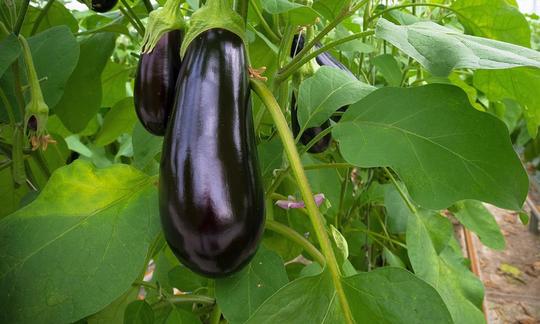

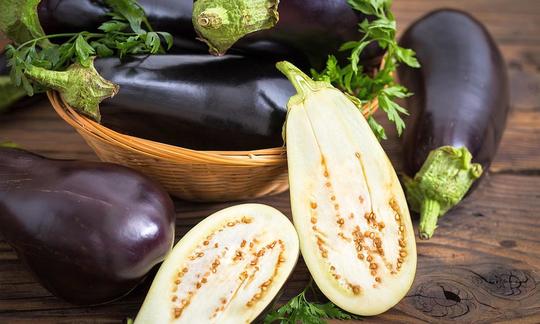

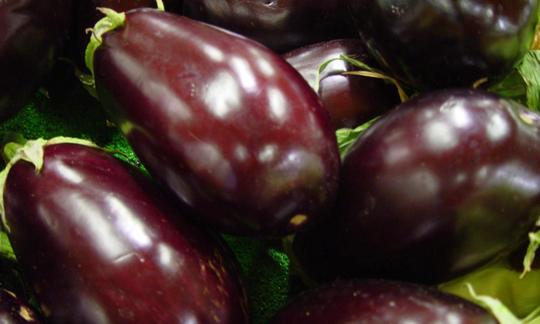

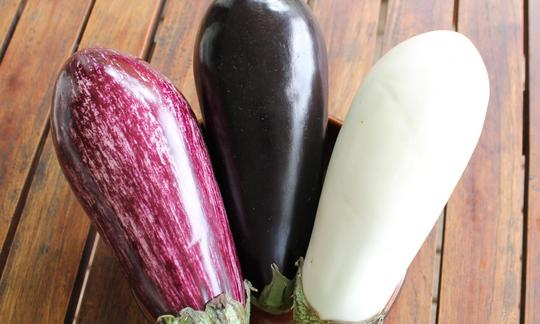



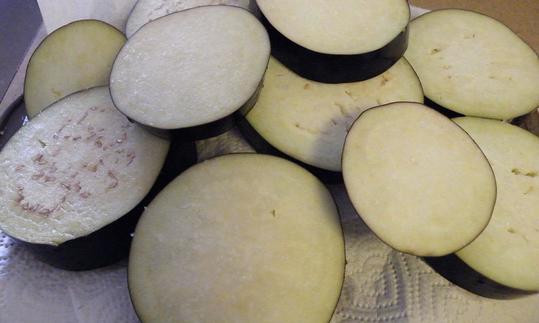

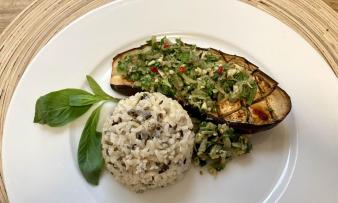

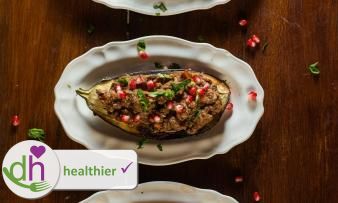





Comments